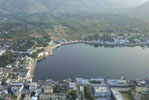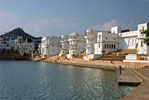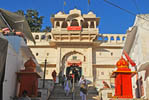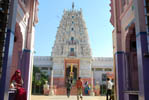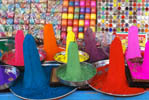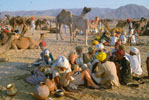|
There is general belief among Hindus that no pilgrimage to the four principal pilgrim centres (Char Dham), namely, Badrinath, Jagannath, Rameshwaram & Dwarka would bear fruit unless one bathes in
the holy waters of Pushkar Lake. Padma Purana, elaborately describes the origin and importance of this lake. It says that Brahma, the creator of the Universe, was once contemplating to locate a
suitable spot on earth to perform a Yajna (sacrificial ritual), the lotus fell from his hand and rebounding, struck at the earth at three places within a circuit of 9 kms. Water issued forth,
from all the three places and the creator called all the three as Pushkar (lotus) distinguishing them as Jyeshtha (Elder), Madhya (central) and Kanishtha (yonger). According to mythology, he
performed the Yajna at Jyeshtha Pushkar from Kartik Shukla Ekdashi to Purnima. Lakhs of devotees assemble and bathe in the holy waters during this period of the year; but bathing on the last day
which is the full moon (Purnima) day, confers special blessing. In recent years, an exclusive accommodation Tourist Village is also erected for foreign tourists. Competitions are organized for them
and cultural programmes are held acquainting them with the Rajasthani way of life and culture. Pushkar has 52 bathing ghats and many temples, big and small; the most celebrated being that of
Brahma, the Creator of Universe.
PLACES OF INTEREST ARE:
Brahma Temple: Though he may have no other temple sacred to his memory, Brahma seems to have take full advantage of the only one where prayers are offered to him. Not only did he perform a Yagya
or ritual fire ceremony here, he also dropped a lotus form his hands to crated the lake where people bathe before offering him prayers. A silver turtle at the entrance of the marble temple is a
symbol of his means of transport. Pushkar is best known for its Brahma Temple, though it is by no means the only temple here, with as many as found hundred temples lining the banks of the lake.
Spires form a skyline that, when the Vesper bells rings, are worthy of the kingdom of heaven itself. Though it visited throughout the year, Pushkar in November, during the time of its
annual fair, is a colourful mass of people & celebrations coinciding with the largest camel fair held in the world.
Pushkar Lake: The Pushkar Lake is surrounded by 52 flights of steps, called ghats, many having special legendary importance. Lord Vishnu is said to have appeared at the Varah Ghat in the form
of a boar. Brahma took a bath here and performed Yajna at the Brahma Ghat, Accompanied by Vishnu and Mahadev. Guru Govind Singh chose this site for reciting the sacred Guru Granth Sahib. The
ashes of Mahatma Gandhi were immersed at the Ghandhi Ghat, which was previously called Gau Ghat.
The Holy dips (Snan) People consider the water of the Pushkar Lake to be very sacred and the ritual of taking dips in the holy water is believed to bestow salvation. The holy dip is most auspicious
on Kartik Poornima. Even before sunrise, people descend the ghats, aided by the pandas (Brahmin priests) to take the sacred bath. Offerings of coconut, flowers and cash are made to the lake & the
priests. After bathing at the lake, people proceed to pay homage to the creator of the Universe, Lord Brahma at the Brahma Temple.
Floating Lamps (Deepdan): It is customary to float lighted earthen lamps after placing them on pattals (plates made of leaves) on the waters of the lake. This creates a spectacular view in the
evening when the sacred lake takes on a mystical tint sprinkled with twinkling spot of light. Aarti is offered at the Lake in the morning and evening.
TOP
FAIRS & FESTIVALS:
Pushkar Fair: The ancient town of Pushkar is transformed into a spectacular fair ground in the month of Kartik. The fair attracts a great number of tourists from far and wide. The fair-grounds
reverberate with festivity, as row of make shift stalls display a bewildering array of items that compete with each other for the visitor's attention. But the highlight of Pushkar fair is the
trading in camels. Camels are bought, sold, decked up and paraded on the sand dunes, presenting a picturesque sight. The camel, horses and donkey races are events that draw huge attendance. Body
tattooing is yet another favourite activity that attracts a large number of enthusiasts. The Pushkar fair brings together a large number of villagers from different Parts of the state. Some come
here to sell. Some come here to buy. Others come here on a pilgrimage. Still others come here just to enjoy the festivities. The days are filled with fun and activities. The evenings are
filled with music and dance. Come dusk, And the rich strains of haunting music are carried across the desert sands. The profusion of colours that run riot in the desert sands, the glee and the
contagious enthusiasm of the village folk are unique experience for every visitor.
SHOPPING:
A large number of traders gather at the Pushkar Fair and sep up shops. They sell a hot of products like bead necklaces of Nagaur, woollen blankets of Merta, textiles printed in Ajmer and Jodhpur,
brassware of Jodhpur and Jaipur etc. Also on sale are saddles, ropes and assorted household items. During the fair, cultural shows and exhibitions are organized to enliven the event. Movies are shown
and competitions are arranged. Bards and poets recite and sing tales of valour and heroism of bygone days. Animal races and other competitions add to the attraction. |







